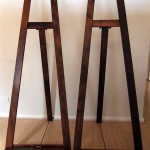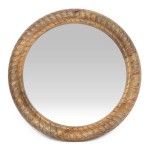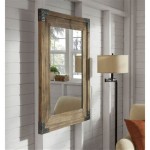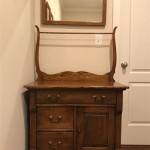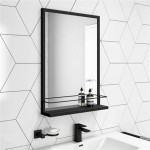How High Off The Floor Should A Bathroom Mirror Be?
Determining the ideal height for a bathroom mirror involves considering several factors, including the height of the individuals using the space, the size of the mirror itself, and the height of the vanity or backsplash. A properly positioned mirror provides both functionality and aesthetic appeal.
One common approach to determining mirror placement focuses on eye level. The center of the mirror should ideally align with the eye level of the average user. However, "average" can be subjective, as household members may vary significantly in height. In households with diverse heights, considering the average eye level of the primary users can provide a good starting point. This usually involves measuring the distance from the floor to the eyes of each individual and calculating the average of these measurements.
Standard recommendations suggest a center height of approximately 58 to 65 inches from the floor. This range accommodates many individuals, but it's essential to remember that these are merely guidelines. Adjustments should be made based on the specific circumstances of the bathroom and its users. For instance, in a bathroom primarily used by children, a lower mirror placement might be more suitable.
Mirror size also plays a significant role in determining the appropriate height. Larger mirrors offer greater flexibility, as they cover a wider vertical range. This allows users of varying heights to comfortably use the mirror without needing precise adjustments. Smaller mirrors, however, require more careful placement to ensure optimal functionality for the intended users.
The presence of a vanity or backsplash further influences mirror placement. The bottom edge of the mirror should typically be positioned a few inches above the backsplash or vanity countertop. This creates a visually appealing gap and prevents the mirror from appearing cramped or cluttered. The specific distance between the mirror and the vanity top can be adjusted based on aesthetic preferences and the overall proportions of the bathroom.
Beyond these general guidelines, considering specific user needs can further refine mirror placement. Individuals with specific requirements, such as those using wheelchairs, may require adjustments to the standard recommendations. In these cases, prioritizing accessibility and ensuring comfortable usage is paramount.
Lighting conditions within the bathroom also impact the effectiveness of the mirror. Adequate lighting, both above and around the mirror, ensures proper illumination and enhances visibility. Poor lighting can negate the benefits of even the most perfectly positioned mirror. Therefore, incorporating appropriate lighting solutions is crucial for optimizing mirror functionality.
The overall aesthetic of the bathroom should also be considered. The mirror should complement the existing design elements and create a cohesive look. Factors like the shape and style of the mirror, as well as the surrounding décor, can influence the perceived height and placement of the mirror.
While adherence to standard measurements provides a useful starting point, flexibility and customization are often necessary for achieving optimal mirror placement. Taking the time to consider the specific needs and characteristics of the bathroom and its users ensures a functional and visually appealing result.
Precise measurements are essential for accurate mirror installation. Using a tape measure to determine eye level, vanity height, and desired mirror placement eliminates guesswork and helps ensure a satisfactory outcome. Marking the desired position on the wall before installation provides a clear guide for mounting the mirror correctly.
In addition to height, the horizontal positioning of the mirror should also be considered. Centering the mirror over the sink or vanity is generally recommended, creating a balanced and symmetrical look. However, adjustments may be necessary depending on the layout of the bathroom and the location of other fixtures.
After installing the mirror, it's important to assess its functionality and make any necessary adjustments. Observing how users interact with the mirror can reveal potential issues with height or placement. Minor adjustments can often significantly improve the usability and overall effectiveness of the mirror.
Choosing the correct mirror and its placement is an integral aspect of bathroom design. By considering the factors mentioned above, one can create a bathroom space that is both functional and aesthetically pleasing. Careful planning and attention to detail will ensure that the mirror serves its purpose effectively and enhances the overall bathroom experience.
Ultimately, the optimal height for a bathroom mirror is determined by a combination of standard guidelines and personalized considerations. By carefully evaluating the individual needs of the users and the specific characteristics of the bathroom, it's possible to determine the ideal mirror placement that effectively balances functionality, accessibility, and aesthetic appeal.
How High Should You Hang The Mirror In A Bathroom With Photos Design Morsels
How High To Place Your Bathroom Fixtures Inspired Style
How To Pick And Hang The Perfect Bathroom Mirror Roomhints
How To Pick And Hang The Perfect Bathroom Mirror Roomhints
How High To Place Your Bathroom Fixtures Inspired Style
How High To Place Your Bathroom Fixtures Inspired Style
Guide To Hanging Bathroom Vanity Lighting And Mirrors Liven Design
How To Pick And Hang The Perfect Bathroom Mirror Roomhints
The Right Height For Elements In Your Bathroom Reno Houzz Au
How High To Hang A Vanity Mirror Sparrow Stoll

